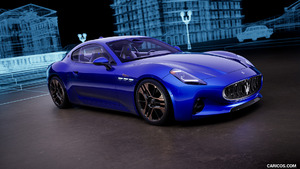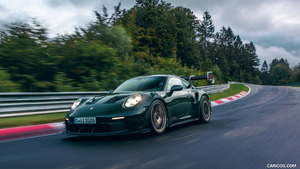2021 SQ5 TDI
- Three-liter V6 diesel engine generating 251 kW (341 PS) and 700 Nm (516.3 lb-ft)
- Twin-dosing technology with two NOx catalytic converters arranged in series
- Powerfully rugged exterior design with striking sporty elements
- Optional Matrix LED headlight and rear lights with digital OLED technology
Even sharper, sportier, and more efficient: The optimized Audi SQ5 TDI now looks even more impressive. Its V6 three-liter diesel engine with an output of 251 kW (341 PS) delivers its power smoothly and forcefully. The sharper design underlines the sporty character of the sport SUV. Rear lights featuring the new digital OLED technology are available as an option for the top Q5 model.
The SQ5 TDI has a successful track record. Its first generation, which was launched in the fall of 2012, already marked the starting point for a success story – as the first Audi S model powered by a diesel engine.
In its latest extended version, the three-liter V6 boasts an output of 251 kW (341 PS) and 700 Nm (516.3 lb-ft) of torque. The wide engine speed range can be used continuously between 1,750 rpm and 3,250 rpm. The 3.0 TDI develops its power earlier and more forcefully than before. It accelerates the top model of the Q5 product line from 0 to 100 km/h (0 to 62.1 mph) in 5.1 seconds and on to an electronically limited top speed of 250 km/h (155.3 mph). An actuator in the exhaust system, as fitted to the first SQ5 TDI, gives the V6 a sonorous sound.
Three-liter TDI with extensive innovations – now even more powerful and efficient
Many details of the V6 3.0 TDI have been revised. The pistons are no longer made of aluminum but of forged steel– the new material reduces heat losses. Due to the higher strength, they do not incur a weight penalty compared with the aluminum pistons. A stepped recess in the piston makes combustion faster and more efficient. The solenoid injectors used to inject the fuel operate with consistently high precision thanks to a new piezo sensor that monitors the closing of the needle. They can perform up to eight injections per work cycle, with injection quantities that are scalable with even greater precision. The maximum injection pressure is 2,500 bar.
 2021 Audi SQ5 TDI
2021 Audi SQ5 TDI
The intercooler has been changed over from an air/air cooler in the bumper to an indirect water/air cooler in the inside V of the engine. The shortened intake air paths help to build up boost pressure quickly. The indirect intercooler is more effective and can even heat the intake air shortly after the engine is started in cold ambient conditions in order to reach the ideal combustion temperatures more quickly. This offers the advantage since exhaust gas cleaning responds more quickly
The turbocharger now features a smaller and lighter compressor wheel that gets into gear with exceptional speed – a key factor in the engine’s spontaneous and high torque build-up. The exhaust manifold benefits from improved insulation. Thanks to this measure, the exhaust gas reaches the optimum temperature more quickly after a cold start.
MHEV and EPC: even greater efficiency and spontaneity
The 3.0 TDI brings two technologies that reduce consumption and improve the engine response. The 48-volt mild hybrid system (MHEV) integrates a belt alternator starter (BAS), a lithium-ion battery that provides buffer storage, and a 48/12-volt voltage converter. When the car decelerates, the MHEV system recovers up to 8 kW of power. The sport SUV can coast for up to 40 seconds with the engine switched off – after which time the powerful BAS conveniently restarts the engine. The MHEV system has the potential to reduce customer fuel consumption by up to 0.7 liters (0.2 US gal) per 100 kilometers (62.1 mi).
The second technology component is the electric powered compressor (EPC), which helps out whenever the exhaust gas flow provides too little energy to drive the turbocharger. A compact electric motor, which also uses the compact 48-volt system, accelerates the compressor wheel of the EPC to 65,000 rpm in roughly 300 milliseconds. The EPC is now used more frequently and across a broader engine map. It supports a more spontaneous engine response when the vehicle moves off as well as when accelerating from low engine speeds. The optimized interaction between the components EPC, MHEV, turbocharger, the engine itself, and the tiptronic transmission supports this effect.
Two SCR catalytic converters interact: the exhaust gas aftertreatment
For exhaust gas aftertreatment, Audi uses twin-dosing technology based two SCR catalytic converters working together. The first of these is located directly behind the manifold in the exhaust gas system, where it also functions as a particulate filter. The second is located further away from the engine under the vehicle floor. Both catalytic converters complement each other’s effects because they cover different operating situations and exhaust gas temperature windows. The SCR catalytic converters are supplied with the AdBlue urea solution from a 24-liter tank. Thanks to twin-dosing technology, the SQ5 TDI comes in substantially below the limits of the new “Euro 6d ISC-FCM AP” emissions standard, which also stipulates a dramatic reduction in NOx emissions in the real driving test conducted on public roads in everyday traffic situations.
Shifting gear quickly and conveniently: the eight-speed tiptronic
Power is transmitted by an eight-speed tiptronic featuring fast and convenient shifting and a gearshift strategy that has been adapted to suit the modified engine. When the SQ5 TDI is in coasting mode with the engine switched off, a clutch in the central transmission opens and interrupts the power flow.
In normal driving conditions, the quattro permanent all-wheel drive system distributes torque between the front and rear axle in a 40:60 ratio. In the event of slip, most of the drive torque goes to the axle with the better traction. Up to 70 percent can flow to the front wheels and a maximum of 85 percent to the rear wheels. During fast cornering, the wheel-selective torque control rounds off the handling with minor brake interventions at the relieved wheels on the inside of the curve.
Sport differential: more torque, no understeer, greater dynamism
On request, Audi can fit the sport differential on the rear axle, which actively controls the distribution of torque between the wheels when the driver adopts a sporty driving style. It sends more torque to the rear wheel on the outside of the curve that has better grip – literally pressing the car into the curve and reducing understeer considerably. The rear wheel on the outside of the curve also receives more torque when the car is accelerating out of tight-radius curves to further improve driving dynamics.
Supreme precision: the suspension
The suspension of the Audi SQ5 TDI is fully equipped to handle the performance of the powerful diesel drive. Five-link suspensions guide each of the four wheels. The S sport suspension with damper control lowers the body by 30 mm (1.2 in) compared with the Q5 and impresses with an exceptionally wide spread between comfort and dynamism.
Together with the optional sport differential, engine, steering and tiptronic, the controlled dampers are integrated into the Audi drive select dynamic handling system fitted as standard. The driver can use it to control the character of these systems in six profiles: auto, comfort, efficiency, dynamic, offroad, and individual. A seventh profile, allroad, is added if the optional adaptive air suspension with S-specific tuning is specified – this air suspension adjusts the ride height of the body through five levels depending on the driving situation. The dynamic steering system is another option module. It uses strain wave gearing to vary the steering ratio as a function of speed and steering angle – from direct and agile at low speeds to less direct and smooth on the freeway.
The updated Audi SQ5 TDI is fitted with 20-inch aluminum wheels with tires in the size 255/45 as standard. Alternatively, 21-inch wheels are available from Audi or Audi Sport GmbH. Six-piston aluminum brake calipers on the front axle grip discs with a diameter of 375 millimeters (14.8 in). The black calipers (red optional) sport S logos.
New accents: the exterior design
The modified Audi SQ5 TDI has a powerful stance, with striking details that give it an even more rugged appearance. Vertical fins provide structure to the large side air inlets on the front bumpers. In the octagonal Singleframe grille that is specific to the S models, large octagonal honeycomb sections are linked by narrow bars. These have an aluminum finish, as do the fins on the air inlets.
Audi includes LED headlights as standard and offers Matrix LED headlights with automatic high beam and dynamic turn signals as an option. At the rear, a matte aluminum strip is integrated in the lower bumpers, below which are the diffuser insert and four chromium-plated oval tailpipe trims. Customers have a choice of nine exterior paint finishes. The black styling package, which adds sporty accents, is available on request.
The latest lighting technology: digital OLED rear lights
Audi offers the new digital OLED technology as an option for the rear lights of the top Q5 model. The OLED rear light is split into three tiles of six segments each. When ordering their vehicle, customers can choose from three rear-light signatures, each with its own specific designs for coming and leaving home. When the Audi drive select mode “dynamic” is activated, the lights change to yet another signature. The OLED rear light also has a proximity detection function that activates all the OLED segments if a road user approaches a stationary SQ5 from the rear to within less than two meters. Dynamic turn signals round out the spectrum of digital OLED rear lights.
Sporty black and gray: the interior
The SQ5 TDI features a black or dark gray interior with illuminated aluminum door sill trims bearing S logos. The electrically adjustable sport seats featuring embossed S logos are available in a choice of three upholstery variants. A leather/ synthetic leather combination is offered as standard while a material mix of leather and Dinamica with S embossing is available as an option. The new Dinamica microfiber material consists mainly of recycled plastic and replaces Alcantara. Another optional variant is fine Nappa leather with a rhombus pattern in magma red. The seats and steering wheel are decorated with contrasting stitching. A massage function with 3 programs and seat ventilation are available on request. The inlays are brushed aluminum as standard. Available alternatives include two carbon versions as well as a piano finish.
The “plus” version of the rear seat bench can be shifted laterally and has adjustable seat back angles. The luggage compartment has a basic capacity of 520 liters (18.4 cu ft), increasing to 1,520 liters (53.7 cu ft) with the rear seat backs folded down. The electrically operated tailgate, a stainless steel loading sill protector as well as aluminum roof rails are fitted as standard. The sport SUV can pull trailers weighing up to 2.4 metric tons (5,291.09 lb) (braked, on a 12 percent incline).
Operating system, infotainment and Audi connect
The MMI touch display with a 10.1-inch diagonal, a central element of the MIB 3 modular infotainment platform, serves as a combined input and display device in the center of the instrument panel. A natural language voice control system and the multifunction steering wheel are available as additional control levels. The 12.3-inch display provides three different graphic layouts: Dynamic, Sport and Classic. Audi offers a head-up display as a further option.
If several drivers use the car, they can store their personal settings in up to six individual profiles. The Car-to-X services of Audi connect can help drivers find parking spots on the roadside. They can also warn of hazards such as slippery roads and fog on the route ahead. The myAudi app connects the car with the user’s smartphone. The Audi phone box connects smartphones with the vehicle’s antenna and can charge them inductively. The optional Bang & Olufsen 3D Premium Sound System with 3D sound provides an extraordinary sound experience. The hybrid radio, which switches automatically between FM, DAB and online streams to find the best reception, ensures that they can listen to their favorite stations wherever they have mobile data reception.
Convenient and precise: the driver assist systems
The SQ5 incorporates all of the assistance systems from the Q5. The turn assist, collision avoidance assist, and exit warning help improve safety. The adaptive cruise assist can take over accelerating, decelerating and keeping in lane for drivers over long distances. The predictive efficiency assist helps them maintain a predictive driving style with the goal of lowering fuel consumption.
The updated Audi SQ5 TDI will be built at the Mexican plant in San José Chiapa and launched on the market in Germany and other European countries during the first quarter of 2021. Its base price is EUR 68,137.82 (in Germany, including 16 percent value-added tax).

















